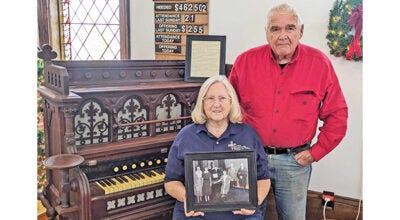Grove Park has deep roots
Published 9:11 am Thursday, May 8, 2014

Berrien Springs’ Grove Park offers a beautiful view of Lake Chapin as well as a large play structure where kids can enjoy the warmer temperatures. (Leader photo/JILL McCAUGHAN)
BERRIEN SPRINGS — A fabulous view, a historical setting and an incredible playground make Berrien Springs’ Grove Park a perfect place to spend a sunny spring day beside the St. Joe.
Situated on the bluff overlooking Lake Chapin, the park is well-known among village residents. However, with its location at the end of South Main St.—well off the main drag—residents of nearby towns may not realize what a lovely spot it is.
Park benches have been placed along the bluff overlooking the lake, created when the St. Joseph River was dammed in the early 1900s. The old bridge pilings from the Interurban Railway can still be seen poking out of the water.
“It is a very well-used park,” said Milt Richter, Berrien Springs’ village president. “It’s known as ‘Grove Park’ around town, but it’s called ‘Wolf’s Prairie Park’ on some maps.”
According to Robert Myers, curator at the Berrien County Historical Association and author of the book “Greetings from Berrien Springs,” the park was purchased by the village in 1881, and its various names originated in different eras of the history of that particular patch of land.
“It’s better known as ‘Grove Park’ nowadays. Lyman Barnard, the town physician, used to potter around down there quite a bit in the later 19th century,” Myers explained. “So, people started calling it Barnard’s Grove.”
The park’s other name, “Wolf’s Prairie,” dates back to an even earlier time when the land was the site of a Potawatomi village led by Big Wolf.
“It was a popular Indian campsite both in the prehistoric times and in the 19th Century,” Myers said. “In the early and mid-19th Century, the prairie land there was a popular picnic area among the Native Americans. People used to call it ‘The Indian Fields.’”
“People still find Indian relics there occasionally,” Richter noted, “but it’s pretty rare these days to find anything like that.”
In fact, a marker placed in the park during the 1960s notes that the land was used as an Indian burial ground at one time.
“The marker says that Indian bones have been found there. That’s probably correct, “ Myers said. “I’ve run across mention of burials taking place there.”
However, Myers disputes another claim made on that same marker—that being that the French had built a fort there at one time.
“There was never a fort there. In the late 1820s, a lot of surveys were done when the U.S. purchased the land from the Potawatomies, and the surveyors would take notes of what was found in each section,” Myers explained.
“One wrote that he could see the remains of the old French fort on that location. I’m not sure what old buildings he might have seen, but there was not a fort there, and there is no evidence of a trading post or a mission having been there either,” Myers said.
Despite the discrepancies regarding its name and what was located there in the past, visitors today will encounter a scenic spot with a large, castle-like play structure that children find enchanting.
“The play structure was built about 5 or 6 years ago with donations from village members,” Richter said. “The park also has restroom facilities, trash facilities, a pavilion and a gazebo.”
In fact, the spot is so picturesque, that a number of weddings have been held there, and it is a popular spot for birthday parties, too.
“If you are a village resident, you can rent the facilities for free, and if you are not a resident, it is only a small fee,” Richter said. “People can call the Village offices at (269) 473-6921 if they want to rent it out.”





